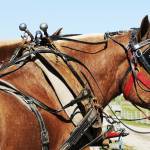Horsepower: An Old Concept Still in Use

Horsepower is generally understood to be the working power of one average horse. More exactly defined by Webster’s Dictionary, one horsepower is “a unit of power equal in the U.S. to 746 watts and nearly equivalent to the English gravitational unit of the same name that equals 550 foot-pounds of work per second.” A foot-pound is the force needed to move a one-pound weight a distance of one foot. Definitions and units of horsepower differ in other countries, especially those that use the metric system.
In the centuries when most heavy work was done by draft horses, owners had a good idea of the amount of work a horse could be expected to do in a day, whether working singly or as part of a team of two, three, or four horses. In general, ponies could do less work than light horses, and draft-breed horses could accomplish the greatest amount of work in a day.
The idea of horsepower came before the actual term was coined in the 18th century by James Watt, inventor of the steam engine, to allow comparison of the power generated by his machine to the lesser strength of horses. Watt estimated a horse’s power by counting the number of times it could turn a 12-foot mill wheel in an hour, settling on a figure of 33,000 foot-pounds of force per minute, or Webster’s 550 foot-pounds of force per second.
In the 21st century, the concept of horsepower is rarely applied to equines, though horses remain an important source of working energy in many countries. Automobiles and other mechanical devices are compared by horsepower ratings and the same general standard can be loosely applied: bigger engines, like bigger horses, can supply the most power.








